|
Species
Biology
English
name:
Mongolian
Gerbil
French
name:
Gerbille
de
Mongolie
Latin
name:
Meriones
unguiculatus (Milne-Edwards, 1867)
Classification
| Subphylum |
Vertebrata |
| Classe |
Mammalia |
| Ordre |
Rodentia |
| Superfamily |
Muroidea |
| Family |
Muridea |
| Subfamily |
Gerbillinea |
| Genus |
Meriones |
| Species |
Meriones
unguiculatus |
|
Commun name |
Mongolian
Gerbil |
Physiology
et anatomy
Length: About
28cm (11 inches),
The tail makes the half of the total length.
Weight:
Between 50g and 110g. The
males are usually bigger the females.
Life
span:
3 to 4 years, can go up to 5 years.
Hearth
rate:
360 beats/minute
Respiratory
rate: 90/minute
Activity
cycle:
The
gerbil doesn’t live only at night as some rodents. It lives during night and
day. Its activity cycle is quite complex but can be resumed as short period of
sleep between periods of activities. Mine all sleep at noon! After a
while they can even match your daily routine.
Fur
The
gerbil takes great care of its fur! It cleans it with his tooths and claws. The
clan members also take care of each other fur by grooming others ones. But in
some cases, fur can have a strang color or some part of it can be missing. Here
are some cases I saw over time.
Belly
sent gland
 The
gerbils have a gland on their belly. It can be seen as a patch of missing fur
right in the center of its belly. You can observe your gerbil rub itself on
every obect in his territory and even on its clan member! It's their way to mark
their territory. Male's gland are bigger then female's. In aged males, infection
may occurs in this area. The
gerbils have a gland on their belly. It can be seen as a patch of missing fur
right in the center of its belly. You can observe your gerbil rub itself on
every obect in his territory and even on its clan member! It's their way to mark
their territory. Male's gland are bigger then female's. In aged males, infection
may occurs in this area.
Barbering or shaving
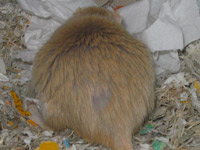 You might see some patch of fur missing on your
gerbils, often on the neck, or near the base of the tail. You don't need to
worry most of the time. It's only the other gerbils that groom to hard and cut
some hairs. But be aware that some infection or parasite may produce loss of
hairs. Verify if your gerbil don't scratch itself too much. You might see some patch of fur missing on your
gerbils, often on the neck, or near the base of the tail. You don't need to
worry most of the time. It's only the other gerbils that groom to hard and cut
some hairs. But be aware that some infection or parasite may produce loss of
hairs. Verify if your gerbil don't scratch itself too much.
Barbering, in mice cases, is a sing of
overpopulation. The dominant mice will shave the dominated mouse.
In the gerbil case, I saw that sometimes, in my
juvenile aquariums when the population was to high, the dominated gerbil had the
base of the tail totally hairless. But no fight occurred.
The molt
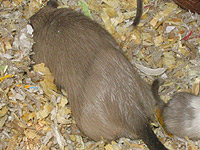 The gerbil changes its fur some times in the year. When it occurs,
you can see a line in the fur. This line will move upward up to the top of the
head and then disappear. The gerbil changes its fur some times in the year. When it occurs,
you can see a line in the fur. This line will move upward up to the top of the
head and then disappear.
The rust
You can see this mostly in dark color gerbils, mostly in breeding females.
The fur under the tail will become orange or yellow. This is caused mostly by
dirty habitat. When the gerbil urinated, it produces ammonia, the same product
used in hair bleaching. The fur is literally discoloured by this chemical. This
is not dangerous for the gerbil but the bedding should be change more often and
the hair color should become normal in the next molt. The rust may also be
visible around the mouth of the gerbil. This is caused by cage bar chewing. The
saliva makes the bar rust and then color the hairs.
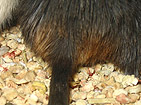
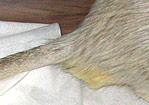
Hairs
missing on the nose
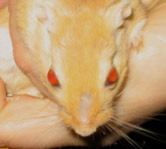 While
gerbils chew cage bares, it care injur itself. By rubing it's nose on the bar,
the fur beging to go away. The only way to stop that is to find your gerbil a
nice aquarium or an habitat where it won't be able to chew barres. The fur
should come back by itself. While
gerbils chew cage bares, it care injur itself. By rubing it's nose on the bar,
the fur beging to go away. The only way to stop that is to find your gerbil a
nice aquarium or an habitat where it won't be able to chew barres. The fur
should come back by itself.
|

 The
gerbils have a gland on their belly. It can be seen as a patch of missing fur
right in the center of its belly. You can observe your gerbil rub itself on
every obect in his territory and even on its clan member! It's their way to mark
their territory. Male's gland are bigger then female's. In aged males, infection
may occurs in this area.
The
gerbils have a gland on their belly. It can be seen as a patch of missing fur
right in the center of its belly. You can observe your gerbil rub itself on
every obect in his territory and even on its clan member! It's their way to mark
their territory. Male's gland are bigger then female's. In aged males, infection
may occurs in this area. 



 While
gerbils chew cage bares, it care injur itself. By rubing it's nose on the bar,
the fur beging to go away. The only way to stop that is to find your gerbil a
nice aquarium or an habitat where it won't be able to chew barres. The fur
should come back by itself.
While
gerbils chew cage bares, it care injur itself. By rubing it's nose on the bar,
the fur beging to go away. The only way to stop that is to find your gerbil a
nice aquarium or an habitat where it won't be able to chew barres. The fur
should come back by itself.